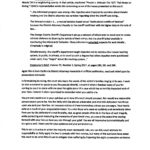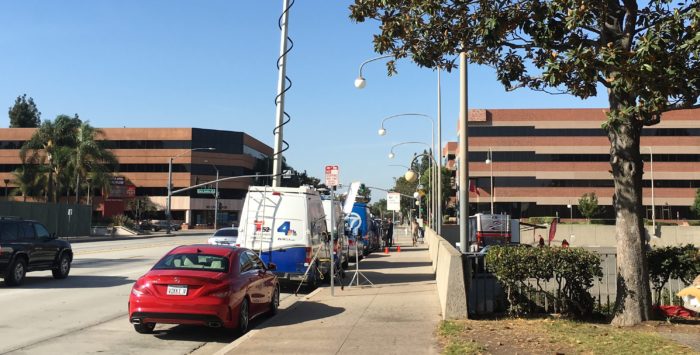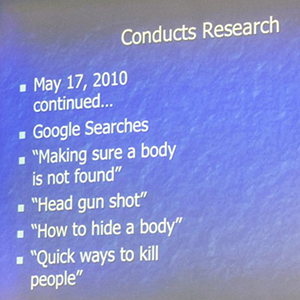I know I promised a post about the recent San Quentin State Prison lockdown, but I’m putting that on the back burner for a bit so I can discuss a major ruling recently made by Orange County Superior Court Judge Thomas M. Goethals in the case of the People v. Scott Dekraai.
Who Is Scott Dekraai?
Scott Evans Dekraai has the dubious honor of being the worst mass shooter in Orange County’s history.
On Oct 12, 2011, he walked into a Seal Beach hair salon and gunned down nine employees, patrons, and a bystander outside. Eight of the victims died in the attack, which Dekraai claimed was motivated by his anger over a child custody battle with his ex-wife. She had been one of the stylists at the salon, and died there.
As with Daniel Wozniak five months earlier, the Orange County District Attorney’s office sought the death penalty against Dekraai.
There would end up being many more similarities between the Wozniak and Dekraai cases, the most important being their shared attorney: Assistant Public Defender Scott Sanders.
The Wozniak – Dekraai Connection
Sanders would discover some troubling “coincidences” as he prepared to defend his two high-profile clients.
It turned out that while being housed at the Orange County Jail, both men had openly spoken about their criminal activities to another inmate. And this same inmate was, out of the goodness of his heart, willing to testify against Wozniak and Dekraai.
Attorney Scott Sanders didn’t buy it. He started digging into the background of this convenient informant, and ended up discovering a hidden system where inmates were cultivated and then rewarded for getting other inmates to incriminate themselves.
The Orange County Snitch Scandal
The Orange County Sheriff’s Office denied the existence of an informant program. The Orange County DA’s Office claimed no knowledge of such a program, and denied ever using any of the information gleaned from inmates. However, through the Wozniak and Dekraai cases, Scott Sanders brought what was to become known as the infamous Orange County Snitch Scandal to the light of day.
The Orange County Weekly journalist R. Scott Moxley has written numerous outstanding articles on the jailhouse informant controversy / snitch scandal. I highly recommended checking out all his work on the subject, especially a recent cover story about Scott Sanders.
The simplified version: the Orange County Sheriffs had their own “snitches” inside the jail trying to dig up dirt on prisoners, without those prisoners’ knowledge, or attorney consent.
That is illegal.
Perhaps you’re thinking, “That’s nothing compared to the crimes committed by Wozniak or Dekraai.”
True. No doubt about it. But through his research, Sanders discovered this infringement on inmate rights had gone on for decades in Orange County. These sneaky tactics had been used over and over again, but most cases don’t have as much damning evidence as was available in Dekraai’s or Daniel’s.
Sanders Files Motions
Defense attorney Scott Sanders wrote long, detailed, and example-laden motions for each of his clients. The one for Daniel’s case was over seven hundred pages long. The Dekraai motion was over five hundred pages. With these motions, Sanders requested hearings on the legality of having a death penalty sentence in two cases that were so tainted with misconduct on the part of the Orange County justice system.
Judge Thomas Goethals, who presided over the Scott Dekraai case, read the lengthy motion submitted by Sanders and agreed to a hearing.
Goethals decided to completely remove the Orange County DA’s Office from the Scott Dekraai case. Judge Goethals stated that Dekraai could not receive a fair trial from Orange County. The case was then handed over to the California Attorneys Generals Office for prosecution. The Orange County DA fought the ruling and lost.
On a side note, Scott Dekraai actually pled guilty to eight counts of murder back in 2014, before all the informant scandal brouhaha. Scott Sanders wasn’t attempting to get either of his clients released. Dekraai’s guilt was not in question. The issue was how he would be punished.
When Dekraai’s case was handed over to the Attorney General’s office in 2015, it was presumed the death penalty would be dropped.
That’s not what happened.
The Dekraai Decision
Finally, Judge Goethals shocked everyone on August 18, 2017, when he ruled that Scott Evans Dekraai, the worst mass killer in the history of Orange County, would no longer be eligible to receive the death penalty. Instead, Goethals sentenced Dekraai to “eight consecutive sentences without the possibility of parole.”
Family members of Dekraai’s victims had mixed reactions. There had been a desire to see this killer face the ultimate punishment, but there was also a sense of relief to have the trial over. But a question remained: would those responsible for the illegal informant program be punished for their own crimes? Judge Goethals stated when handing down Dekraai’s sentence, “No individual or agency is above the law.”
Read the Ruling
I’ve attached the nineteen-page ruling by Judge Goethals – which is more interesting than you’d think – but if you don’t want to read it, it basically states that taking away the death penalty was his method of punishing the OCDA for wrongdoings (“Sanctions related to ongoing discovery abuse.”)
Goethals clearly wasn’t happy about having to make this choice. From the ruling:
If this case had been prosecuted from the onset by the Orange County District Attorney within the most fundamental parameters of prosecutorial propriety this defendant would likely today be living alongside other convicted killers on California’s Death Row in the state prison at San Quentin.
And the Wozniak Decision?
That brings us back to my friend Daniel Wozniak, who has been living on death row for a year now.
Judge John D. Conley, who was presiding over Daniel’s case, received Scott Sanders’ 754-page motion, but somehow didn’t find it convincing enough to even grant a hearing on the question of prosecutorial misconduct.
Where Judge Goethals saw egregious behavior on the part of the Orange County Sheriff and the Orange County District Attorney’s Office, Judge Conley detected no infringement on Daniel Wozniak’s constitutional rights.
I have to say though; Judge Conley must have seen some similarities in the two cases because during Daniel’s trial, Conley once accidentally referred to him as “Daniel Patrick Dekraai.”
Look I’m no “Rocket Lawyer” (“Lawyer Scientist?”), but it sure looks like Daniel will have some major, taxpayer funded, appeals coming his way specifically because of Judge Conley’s refusal to hold a hearing about the use of illegal informants.
I heard (and read) Matt Murphy’s repeated claims that the prosecution wasn’t planning to use any of its illegally obtained information during Daniel’s trial, so nobody’s rights were violated.
Rachel and Tim are Charged… A Consequence of Informant Info?
Although, two years after the crime, and soon after Daniel’s contact with the snitch, the OCDA arrested and filed charges against Rachel Buffett and Daniel’s brother, Tim.
They found out some new information… somewhere…
Even if the Orange County District Attorney learned absolutely nothing from the OC Sheriffs to “use against” Daniel Wozniak during his trial, they still violated his rights. Judge Goethals didn’t need to see the District Attorney’s office use illegally obtained information against Scott Dekraai before he decided to punish the DA by taking away the death penalty.
The Future For Wozniak and Dekraai
Right now, Daniel is on death row, and Scott Dekraai will be heading to a maximum-security prison for his eight life terms without parole. We can assume both men will die behind bars.
But with over seven hundred death row inmates ahead of him, there is a very low likelihood Daniel will ever be executed by the state of California. There will be a lot of money spent on him before he, one day, dies of natural causes.
Maybe there are family members of Dekraai’s victims who are livid that their murderer escaped the death penalty.
During the punishment phase of Daniel’s trial, we heard gut wrenching testimony from the loved ones of Sam Herr and Julie Kibuishi. There was no doubt they wanted Daniel Wozniak to die in San Quentin (sooner rather than later). Sam’s dad, Steve, called Daniel the “poster child” for the need to have a death penalty in California. So, maybe it gives the families a tiny bit of relief from their misery imagining Daniel living “under the threat” of death every day. If so, that seems as good a reason as any for Daniel to be on death row.
I suspect Daniel will spend quite a few years in his current location, but will eventually have his death penalty overturned on appeal.
Don’t stress out though. He’ll still die behind bars. Just not with a view of San Francisco Bay.


















 I’ve spent a lot of time with Daniel this past week, so I’m behind in getting a post out. I’ve been visiting him officially as a member of the media. That meant I was able to visit him during off hours, and for much longer visits.
I’ve spent a lot of time with Daniel this past week, so I’m behind in getting a post out. I’ve been visiting him officially as a member of the media. That meant I was able to visit him during off hours, and for much longer visits. The courtroom was packed that day. Many of the seats were filled with Sam’s and Julie’s family and friends. Relatives had even flown in to witness Daniel Wozniak’s sentencing. The Herr family brought an Army battalion (I’ll explain that when we get to the victim impact statements in the next post).
The courtroom was packed that day. Many of the seats were filled with Sam’s and Julie’s family and friends. Relatives had even flown in to witness Daniel Wozniak’s sentencing. The Herr family brought an Army battalion (I’ll explain that when we get to the victim impact statements in the next post).